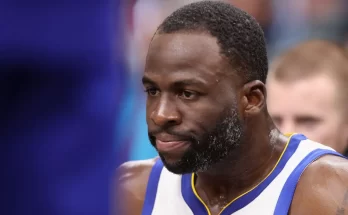Will Howard, the standout quarterback from Kansas State, has been generating buzz throughout the college football world for his remarkable ability to elevate his team’s offensive ceiling. As he nears the conclusion of his collegiate career and prepares to enter the 2025 NFL Draft, many scouts and analysts project that he will be one of the top signal-callers selected. What sets Howard apart is not simply his physical talent—though his arm strength, accuracy, and poise under pressure are unquestionably elite—but also the leadership qualities he brings both on and off the field. He’s the kind of competitor who commands respect in the locker room, rallies teammates in the huddle, and remains unflappable in pressure situations. As a result, his presence alone can galvanize an entire offense, often elevating performance around him.
Howard isn’t flying under the radar; he heads into the pre-draft process with enhanced visibility thanks to an outstanding junior year that saw him consistently torch defenses with a balanced blend of pocket presence, timing, and the occasional improvisational scramble. What separates him from many of the other quarterback prospects is his refined understanding of offensive systems and his ability to read the field on the fly. NFL talent evaluators frequently highlight his film review habits, work ethic, and cerebral approach to the game. Each week, scouts note that Howard clearly internalizes game plan adjustments, recognizes defensive disguises, and makes precision decisions—even on the most seemingly mundane throw downs. That level of football IQ is precisely what pro teams covet.
But Howard isn’t the only major name expected to hear his name called early from the Buckeyes. Ohio State’s football program, long a pipeline to the NFL, is showcasing a host of potential top-tier prospects ahead of the 2025 Draft. One name that immediately stands out is Marvin Harrison Jr., the explosive wide receiver whose rare combination of size, speed, hands, and production has thrust him into national player of the year discussions. Scouts rave about his uncanny separation ability, route-running polish, and his knack for coming down with contested catches over bigger defenders. He’s a polished route technician, smart and savvy with his location in and out of breaks, yet he also has the game-shifting burst to break the top and turn a quick pass into a highlight reel. NFL talent evaluators describe him as a “complete receiver” unlikely to fall past the first round, with many projecting him as a top-five pick due to his immediate ability to impact a pro passing game.
Another elite Buckeye prospect is defensive end Jack Sawyer, a disruptive edge rusher who has generated fervent excitement among scouts due to his athleticism, bend, motor, and production. Sawyer excels at turning the edge, has a well-rounded arsenal of pass rush moves, and consistently influences games with his presence—even when he fails to get home. His ability to collapse the pocket, chase down mobile quarterbacks, and anchor one-on-one matchups make him a valuable NFL commodity. College coaches credit his relentless motor and excellent feet for allowing him to navigate blockers and maintain a threat throughout prolonged plays. At the next level, his blend of physical traits and technique refinements have many teams envisioning him as a foundational defensive piece capable of anchoring a 4–3 front or serving as a versatile hybrid rusher in nickel schemes.
Tight end Cade Stover deserves national attention as well. Listed at over 6’5” and 260 pounds, Stover pairs his imposing frame with soft hands, route versatility, and an uncanny knack for positioning in contested areas. NFL personnel departments see in him a modern tight end who can both stretch the seam and work between the hashes. What makes him uniquely attractive is his ability to impact the passing game in three phases: intermediate zones, underneath crossers, and in the red zone. He’s dangerous after the catch, too, leveraging his size and strength to secure additional yards. Critics of tight end prospects often cite blocking limitations, but Stover has made marked improvements in his run-blocking technique, showcasing enough willingness and competency to be a two-way threat at the pro level. With his high ceiling, Stover is comfortably projected as a mid‑to‑late first‑round pick available to teams seeking to enhance their mismatches in the passing game.
Ohio State’s receiving depth extends beyond Harrison Jr. Emeka Egbuka, a shifty slot specialist with consistent hands, quickness, and run-after-catch ability, is expected to hear his name called within the early rounds. He excels in short-to-intermediate spaces, threats for explosive gain after the catch, and shines on screens and slot concepts. His football instincts and savvy route-running have earned praise. Meanwhile, prospect prospects like wideouts Julian Fleming and Kobe Lisa add further depth and draft capital to Ohio State’s offensive tree. Fleming remains one of the nation’s most physically gifted receivers—with high-end speed and ball skills—while Lisa offers big-play potential after flashes of dynamic production, enough to get on teams’ radar during the combine.
On defense, Ohio State’s run-stopping linebacker Steele Chambers presents scheme versatility. Capable of playing downhill in the box yet light enough to cover, he calls himself a “Swiss Army Knife” on the field. NFL evaluators have rewarded his instincts, tackling reliability, and his ability to navigate traffic. While some scouts expressed concerns about his ceiling and pass-coverage range, they consistently note his football IQ, consistency, and impact on winning defensive units.
Running back TreVeyon Henderson has also showcased himself as an explosive back who makes defenders miss and runs with sudden acceleration. Though a few teams question his lack of bulk, Northeast reviewers suggest he can adapt with an NFL strength program—and his elusiveness and shiftiness are seen as more than compensatory. Henderson offers potential as a third-down back or complementary starter in dynamic offensive attacks, particularly due to his catching prowess and vision.
Circle back to Will Howard, and it becomes clear why he and the Ohio State contingent are central stories heading into the spring and summer. Howard’s leadership amid personnel turnover, brutal game-time adversity, and mounting expectations underscored his character. His regular-season stats—completing nearly two thirds of his passes, throwing for well over 4,000 yards, and maintaining a touchdown-to-interception ratio among the best in his conference—weren’t just byproducts of talent, but also of an infectious drive. In meeting rooms and weight rooms, teammates say Howard pushes himself beyond the delineated game plan, reveling in grind days and film sessions. That off-field approach parallels the elite pro preparation his draft projection demands.
Meanwhile Ohio State’s NFL-destined stars have maximized their opportunity playing in one of the most prepped, tightly managed programs in college football. Head coach Ryan Day, offensive coordinator Brian Hartline, and assistant staff are frequently praised for grooming NFL-level skill sets, from split-zone spacing offenses to pressurized defense calls. The players’ involvement in pro-style installations, fancy route concepts, and high-level processing systems amplify their readiness for the NFL transition.
As the draft season draws nearer, Howard and the Buckeyes prepare to translate their production and traits into measurable testing environments—like the NFL Combine, Pro Day workouts, and pre-draft interviews. Will Howard’s workout outcomes will play a pivotal role. While his arm and accuracy match or exceed many NFL counterparts, clarity will emerge on his 40-yard dash, agility drills, and positional measurements—benchmarks that could shift his draft spot from early mid-round into potential first‑round contention. For Harrison Jr., speed and quickness drills may validate his early round grade; likewise, scouts will evaluate his contested catch scenarios in the vertical drills. For Sawyer, bench press and shuttle times will reveal his functional strength and movement quality. For angle‑free, fast‑twitch readers like Egbuka, Fleming, and Lisa, eye-popping short shuttle or three-cone times could elevate their stock from late-round flyer to Day 2 lock.
Despite the clear momentum ahead of the 2025 Draft, questions remain—and that’s to be expected. With Howard, refinement in pre-snap processing and decision-making under blitz pressure will answer critical pre-draft inquiries. Scouted weaknesses include occasional slow reads on heavy disguises, or timing windows taking fractional hits against high-level pressure. NFL scouts come in with rapt attention on how he wheels into engagement, slides in the pocket, and reads open progressions while avoiding sacks. His interviews will matter too; franchises prioritize leadership, character, and coachability. Howard enters this phase with a strong public persona—reportedly articulate, honest, and introspective—which gives a favorable impression among NFL brass.
Ohio State’s stars face their own scrutiny. Harrison Jr. must prove route timing and separation remain elite against pro-caliber athletes, and that he can adapt to press-man coverage. Sawyer will be evaluated on ironclad strength and pass-rush versatility against NFL blockers, beyond his dominant college tape. Depth concerns will touch linebackers like Chambers—will he fit third-down packages, or need to transition into hybrid sub-schemes? And running backs such as Henderson will need standout agility testing to counterbalance his smaller profile.
Yet all signs point to a strong showing at the Combine and Pro Day. Howard is reportedly consistently throwing 60-plus passes per practice, demonstrating repeatable accuracy and velocity. Harrison Jr.’s timed workouts are generating buzz, while lead scouts report Sawyer’s vertical and shuttle tests surpass positional thresholds. Add to that Florida-based pro scouts describing Ohio State’s practice environment as highly competitive—replicating pro-level intensity—and the compelling narrative of elite prospects fully prepared to take the next step.
The franchise implications are significant. NFL teams selecting in the first round—including quarterback-needy clubs, those seeking a future No. 1 receiver, or teams stealing edge talent early—will prioritize traits these players deliver. Will Howard represents a high-upside quarterback project with pro-style chops, a strong arm, and leadership—elements teams will weigh heavily. Marvin Harrison Jr. offers a dream receiver for any quarterback pairing, a mismatch creator and chain-mover. Jack Sawyer is a premium edge talent, capable of immediate impact. Combined, the Buckeye cohort offers the kind of multi-positional talent stretch that fuels a successful Draft day run.
As 2025 combines, pro day workouts, positional drills, character interviews, and mock drafts play out over the coming months, Howard and the Buckeyes will remain center stage. Draft night promises a blended show: a bright quarterback with a demonstrated ceiling, injective weapons in the passing game, and defensive heat to shake up lineups league-wide. Should all go well, Howard and his Ohio State comrades will hear their names called early—and their next steps will start a ripple of impact through the entire talent-rich 2025 Draft class.
In sum, Will Howard and Ohio State’s top remaining players project as cornerstone NFL prospects, each bringing a winning combination of physical gifts, football intelligence, leadership, and pro readiness. Their collegiate accomplishments paired with upward trajectory make them names to watch. As the offseason pro grind heats up, so too does the attention on a group defined not just by zip code, but by readiness to thrive on Sundays.


